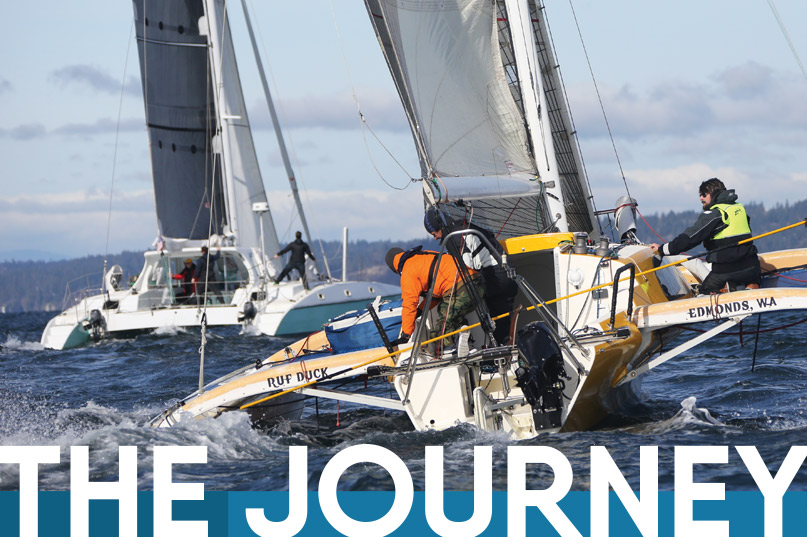
 “Down, down, down!” I shout over the 20-knot wind as a deadhead, a proper log, appears on our course. “DOWN!” Jeff Oaklief, president of the Northwest Multihull Association (NMA) and owner of the Farrier F9R trimaran Ruf Duck, adjusts the course off the wind in the nick of time.
“Down, down, down!” I shout over the 20-knot wind as a deadhead, a proper log, appears on our course. “DOWN!” Jeff Oaklief, president of the Northwest Multihull Association (NMA) and owner of the Farrier F9R trimaran Ruf Duck, adjusts the course off the wind in the nick of time.
“Nice call!” says Oaklief as Ruf Duck zips past the potential hull-damaging log at a sporting 16 knots. He resumes course toward the Seattle cityscape that towers proudly into the sunny February sky. Today’s Blakely Rock Race, the first of the Center Sound Series, is supposed to be overcast with five knots of wind. Leave it to the late winter/early spring Pacific Northwest weather to surprise us with a gorgeous day and brisk wind. I look over to the other crewmates, Scott Wallingford and Li Sung, who are with me on the windward arm of the tri for our downwind run. We’ve rounded Blakely Rock and scheme our course back to Shilshole Bay.
Why are we on Ruf Duck in the first place, you may ask? Wallingford, Sung, and I are training for the Northwest Maritime School’s (NMS) fourth iteration of the Race to Alaska (R2AK), the Pacific Northwest’s most iconic adventure race. We, Team Wright Yachts, are scheduled to do the 750-mile, engineless race in a Corsair 970 Sport performance trimaran dubbed Wright 1. The catch? Our boat is currently under construction in Vietnam and we need to practice.
While our team has plenty of combined nautical experience, including Sung’s PhD in Ocean Engineering and U.S. Navy tenure, and Wallingford’s decade-plus marine industry career, we are by no means multihull racing gurus yet. In fact, this race aboard Ruf Duck with Oaklief is our first official race together, and, for most of us the first time aboard a performance tri. Thankfully, the spring sailing season in Puget Sound gives us a near-weekly chance to race with Oaklief and the NMA, who’ve graciously taken us ducklings under Ruf Duck’s wings. Bust out the pump-up music and boxing gloves because it’s training montage time.
We finish the Blakely Rock Race, not first by any means but not in disgrace either, and help Oaklief get Ruf Duck on the trailer. Someday soon, we’ll be doing this kind of setup and breakdown in our own craft.
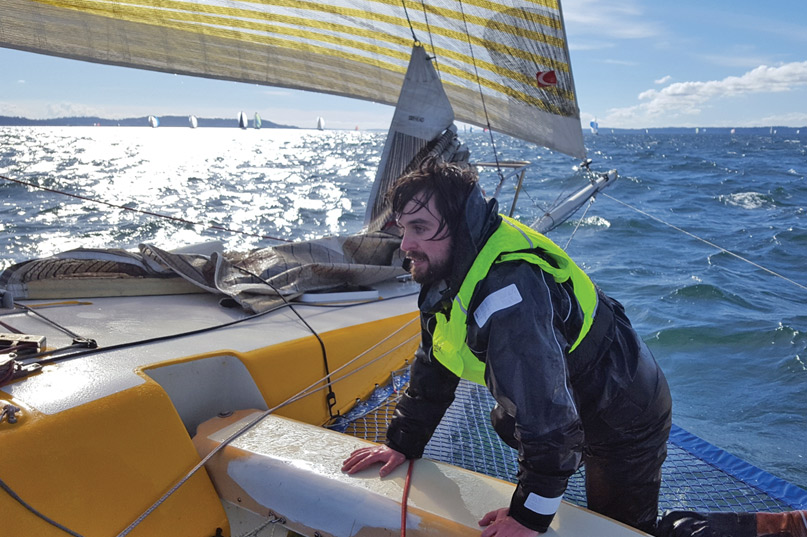
“Nice hustle,” Oaklief tells us in his breakdown of the day. “Even brought me a coffee… and I pretty much need my coffee. Crew work is showing promise, and you seem to have figured out the jib, screecher, and main. You have my trust on those now, so the spinnaker is next on the list… that and getting folks on the helm.”
One race down. A lifetime of learning to go.
A lot has happened since Team Wright Yachts announced to the world that we were taking on R2AK in Northwest Yachting’s January 2018 issue. Readers of that story will probably be wondering what happened to National Oceanic and Atmospheric Administration (NOAA) Corps Officer Kathryn Richwine, our fourth team member. In short, life. Being the superwoman that she is, she decided to focus on racing competitively in her upcoming marathon, dominating her NOAA career, and other such goals. Sometimes, an adventure race just doesn’t fit into one’s plans. Maybe next year, and we’ll certainly miss her when it comes time to peddle.
The remaining three of us have thus adjusted our strategy. The drawback of being a bare-bones crew will be the increased fatigue on each crewmember over the course of the multiple days of the race.
“Mastering our crew rotation so we can get rest will be critical,” says Wallingford. “If all goes to plan, we’ll finish Leg 2 and get to Ketchikan in about four days. We’re all going to need to get some kind of shut-eye during that time.”
On the plus side, a barebones crew has the advantage of less weight aboard. The racing mindset dictates that every pound of weight not aboard is its own victory, and the weight demands of each crew is the sum of his or her body weight, water and food consumed, gear, etc.
Every person represents potentially hundreds of pounds. In short, like all things R2AK so far, hopefully the pros of our decision outweigh the cons. We’ll only know for sure once we hobble over that finish line.
But what of our vessel under construction abroad? Our ragtag group’s shot at R2AK has been made possible by Rob Wright of Wright Yacht Sales, the local dealer of Corsair trimarans. Wright is essentially letting us take his inventory on a joy ride before finding it a permanent home, perhaps with another R2AK dreamer for next year.
With the Blakely Rocks Race under our belts and team confidence growing, I pack my bags for a trip to Vietnam to see Wright 1 for the first time. In my absence, Wallingford and Sung prepared for another training race aboard Ruf Duck, the Center Sound Series Scatchet Head Race. R2AK prep never stops.
The food carts and businesses on the other side Cu Phú Thuân (Phu Thuan Bridge) in District 7 of Ho Chi Minh City (formerly Saigon) have no rhyme or reason where they spill onto the sidewalk. The concrete, single-room shops are laid open to the world this Tuesday morning as Rob Wright and I make our way from our accommodations to the Corsair Marine International Factory for the first time. A man welds an ornate gate in one room while a woman peddles purses in the next. We pass food carts selling freshly baked Bánh mì (baguettes) and writhing eels fresh from the nearby Saigon River. Motor scooters overloaded with bundles of sugar cane and children chug by in the hundreds.

We’ve been in Vietnam less than 24 hours, and as the sun and barometer rises, so do our appetites. Fortunately, we have time before we are to meet up with Shane Grover of Corsair, who is going to introduce us to Wright 1. She’s almost ready for Pacific Northwest delivery and commission, and Wright is dropping in as a formality and to sate his curiosity. I feel lucky to tag along, especially as we stop for a coffee.
I didn’t anticipate the café culture of the country, perhaps something picked up from the French colonization, and men fill the small shop that we visit, nursing the highly concentrated ice coffee (cà phê sữa đá) and smoking cigarettes. We stop in at a three-table phở shop, and the grandmotherly owner simply holds up two fingers. I nod, and two giant bowls of soup appear for 60,000 Vietnamese Dong apiece, roughly $2.50 USD.
We arrive to the factory right on time and pass a small army of Vietnamese wearing identical Corsair Marine work onesies leaving the factory. They are on break and line up near a few savvy food carts waiting on the side of the road. Shane Grover greets us, a young Aussie with nearly a decade working with Corsair under his belt. He moved from Oz to Vietnam with the company and has made himself right at home with his Vietnamese wife and language proficiency.
“Let’s show you guys about the factory, then,” says Grover after introducing us to the office staff, a friendly mix of Aussies and Vietnamese. We enter the Corsair assembly facility and are greeted with about a dozen builds in various stages of completion. My eyes snap to the 970 on the far side of the factory, and we make our way over.
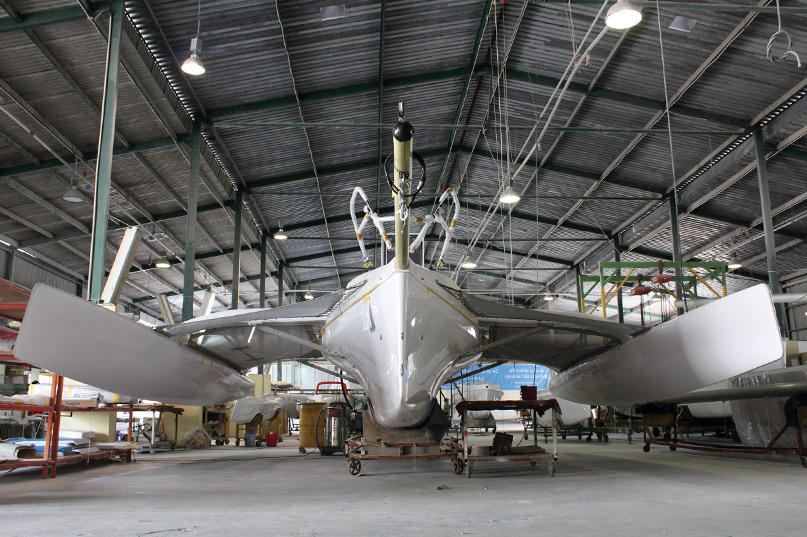
“Is this it?” asks Wright.
“This is it,” says Grover. I, in awe, run my hands along her hull. Wright 1’s arms have been recently attached, and a few workmen aboard are finishing the interior. Grover procures the carbon fiber bowsprit and sticks it into the bow. “Over there’s the mast,” he points, and we check it out. Wright 1 will feature the carbon fiber racing option, which cuts down on evil weight considerably. Grover demonstrates by lifting the entire mast with one hand.
I’m a little distracted as Wright and Grover hash out specifics. Someday soon, Team Wright Yachts will be dependent on this boat for the sake of glory chasing and safety at sea. Although saddened we don’t get to take her out on the Saigon or Mekong rivers for a test run, the anticipation of that first sail has me nearly shaking with excitement.
This year’s race marks the fourth R2AK event, and at the time of this writing there is a total of 23 teams registered for the entire race course. In classic R2AK form, the array of teams represents the range of racing strategies from Team Extreme Sobriety aboard a Blakely Board SUP (crewed by Bainbridge Island resident Steve Rhoades) to performance multihull teams not unlike our crew. The deadline to apply for registration is April 15, a date fast approaching as I write this.
R2AK 2018: Larger Performance Competition (as of March 20, 2018):
Team PT Watercraft
Port Townsend, Washington, USA
Boat: Gougeon 32 Catamaran (32’)
Members (3): Russel Brown, Ashlyn Brown, and Alex Spear
Team Ptarmigan
Glenwood Springs, Colorado, USA
Boat: Farrier 28 Trimaran (28’6”)
Members (4): Bo Bohanon, Kelsey Bohanon, Molly McPartland, and Jack Gallagher
Team Sail Like A Girl (pictured)
Bainbridge Island, Washington, USA
Boat: Melges 32 (32’)
Members (9): Jeanne Goussev, Aimee Fulwell, Anna Stevens, Kate Hearsey, Allison Dvaldze, Kelly Danielson, Morgana Buell, Leslie Lorenze Karduck, and Morgan Roose Rohrbach
Team Strait to the Pool Room
Mission, British Columbia, Canada
Boat: Shaw Catamaran (34’)
Members (4): Michelle Riedlinger, Graham Shaw, David Thomson, and Jennifer Metcalfe
Team Swan Song
Durango, Colorado, USA
Boat: Corsair 28CR (28’6”)
Members (4): Walker Douglas, Cap Allen, Anne Markward, and Glenn Bland
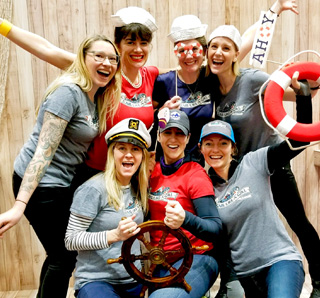
Like previous years, R2AK 2018 will feature the same course and lineup. After the Pre-Race Ruckus in Port Townsend on June 13, the starting gun will go off at 0500 hours on June 14 to the sound of Soviet-era comrade music and cheers of the crowd. That first day has been dubbed the “Proving Ground,” a 40-mile Leg 1 to Victoria across the open Strait of Juan de Fuca. It’s a test that preferably washes out the unprepared teams at this early stage rather than hundreds of miles from help. The only race rules that apply are engines are outlawed and no special supply arrangements can be made.
Once in Victoria, the crews get an evening party that night and a lay day on the 15th to steel themselves for the Leg 2, a 710-mile jog through the Inside Passage up to Ketchikan, Alaska. The two waypoints of Leg 2, Waypoint 1 of Seymour Narrows and Waypoint 2 of Bella Bella, are meant to force the teams into the tactically challenging passes. Seymour Narrows is considered by many to host the largest tidal swings in the world, and the buzz among marine biologists are that even migrating whales must wait for the 18-knot tides to swing in their favor before passing.
The irreverent, cavalier culture is one of the main attractions of the race. Although a tasty first-place cash prize of $10,000 nailed to a chunk of wood is offered as incentive, all those who even finish the race are considered winners with about 50% of teams washing out in a typical year. Second place is an infamous set of steak knives. One clever incentive by the NMS for lower-budget crews is that they offer $10,000 to every team that finishes for their boat. The first one to say yes, gets it. In theory, one could home build a sailing canoe and make a nice profit, provided they beat everyone else who’d be interested in the exchange.
Additionally, highly-coveted awards are also motivators for various teams. The prestigious Dirt Bag Award goes to the highest performing team on a shoestring budget, for example, and is just as prestigious as first place on a spiritual level.
Team Wright Yachts has plenty to do before the start gun in Port Townsend on June 14. Most notably, we eagerly await the arrival of our beloved Wright 1 from overseas. With an ETA of “mid-late April” and local commissioning to boot, we don’t have a lot of wiggle room with regards to tweaking our race platform.
“I’m confident that the boat will arrive on time,” says Wright. “But an arrival of April with commissioning to do means that, practically speaking, we’ll be racing her in the water early May, about a month and a half before the starting gun.”
Corsair Marine International, known simply as “Corsair” in multihull circles, is a world leader in multihull manufacturing with over 30 years of operation. Originally Australian based, the company now operates out of Ho Chi Minh City, Vietnam. Known both for its trailerable performance Corsair trimarans and luxury cruising Seawind catamarans, the company touts over 2,000 trimarans built.
Much of the success of the trimarans is due to their folding arm technology that not only makes them easier to fit into a slip but also trailerable. This design was pioneered by trimaran design legend Ian Farrier, who helped put the company on the map in the early days. You can look at their complete lineup of performance trimarans at corsairmarine.com and luxury catamarans at seawindcats.com.
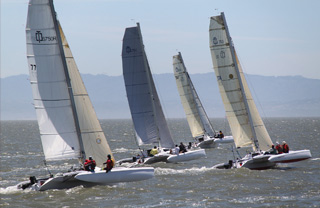
In the meanwhile, the team will continue our near-weekly training with Jeff Oaklief and the NMA in the local racing circuit. The Center Sound Series Blakely Rock and Scachet Head races were a great start to the team’s multihull racing career. Fortunately, most of the legwork with regards to logistics planning are not dependent upon Wright 1’s arrival. Rations, gear, equipment, and the like are constantly schemed at frequent team meetings at our unofficial headquarters, the Sloop Tavern of Ballard across from the new Nordic Museum.
Li Sung is also pulling the trigger on the human-powered element with his own not-patented design. While I’m not at liberty to divulge the intricacies of our secret weapon, construction is underway and everything about it is homegrown from the University of Washington shop.
The bottom line is that Team Wright Yachts is a fair distance into a long journey. The reality of our commitment has sunk in, and it’s clear that navigating the 750-mile course is the final reward for months of preparation. All the in-water training, over-drinks scheming, and international wheeling and dealing will come down to a handful of intense days on the water during the actual race if all goes to plan. Why? Why throw ourselves into this mess? Why go through so much just for a shot at what guarantees to be a trial in the wilderness for no apparent reason?
I think back to my time in Vietnam, a Buddhist majority nation once torn by war. The Buddha once said in the The Udana text, “Just as the great ocean has one taste, the taste of salt, so also this Dharma and Discipline has one taste, the taste of liberation.” R2AK, the liberation through discipline of the mind. A salty taste indeed.


